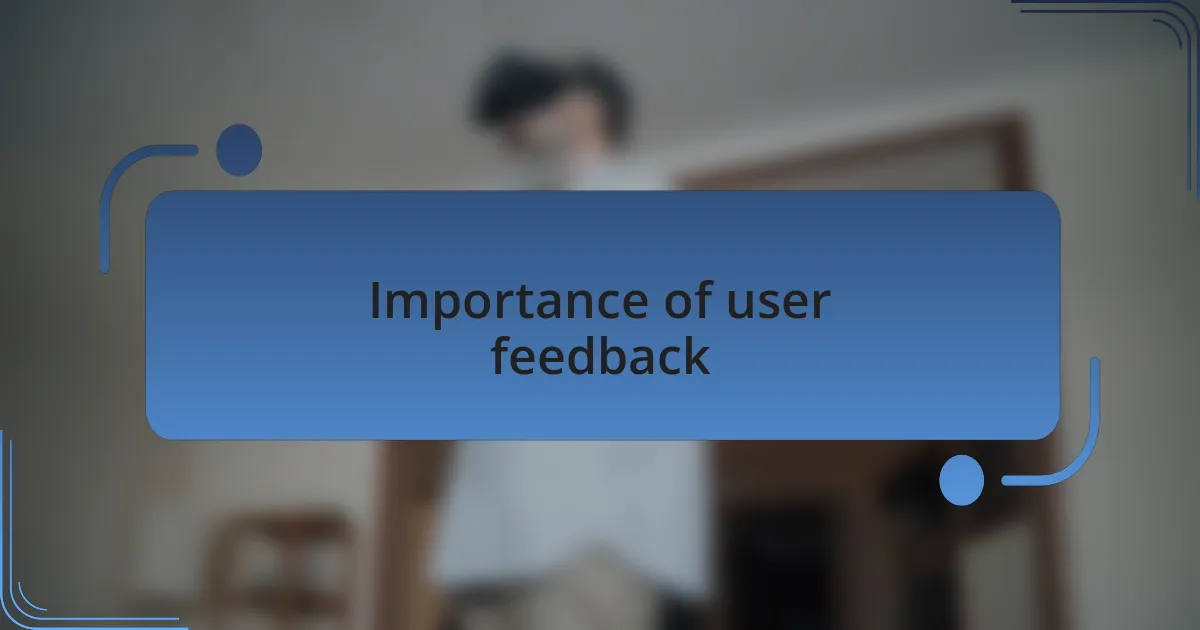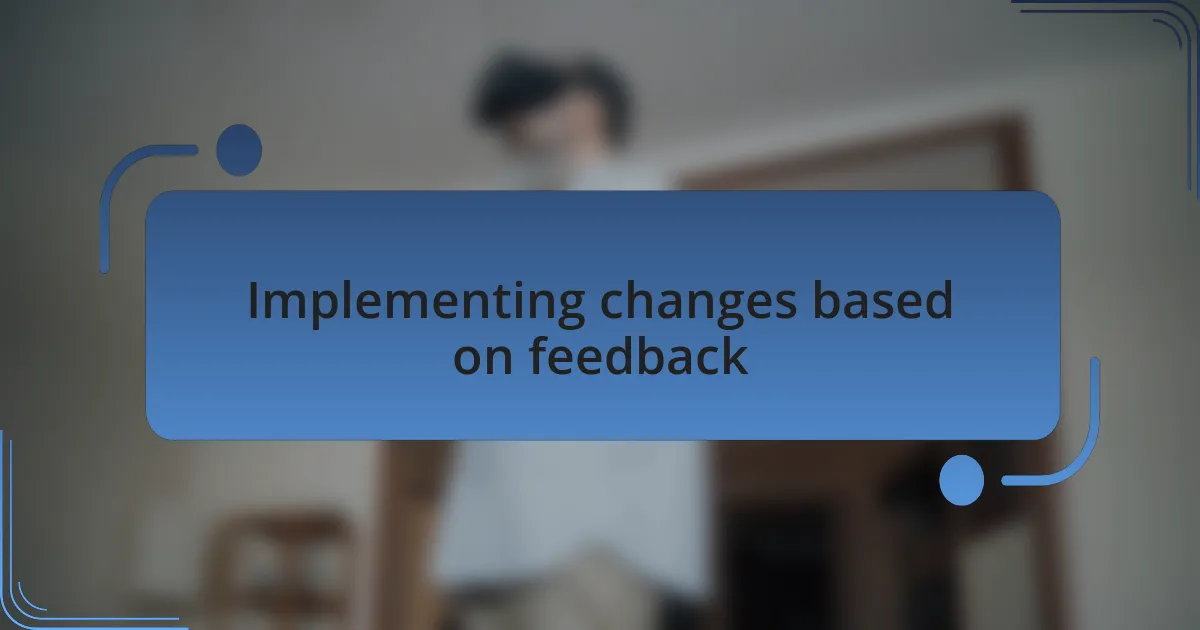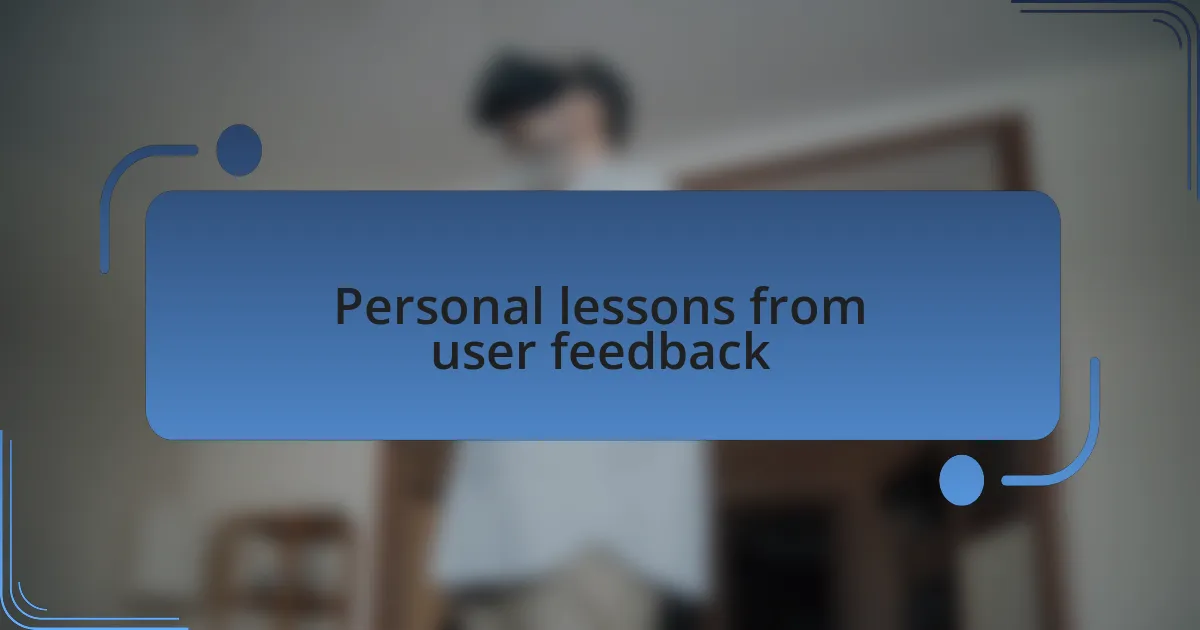Key takeaways:
- User feedback is essential for improving web design, fostering a connection with users and enhancing their experience.
- Common themes in feedback include navigation issues, design consistency across devices, and accessibility for users with disabilities.
- Effective analysis of feedback involves categorizing insights, understanding implicit user emotions, and directly engaging with users for deeper understanding.
- Implementing user suggestions through experiments and redesigns can lead to significant improvements in user engagement and satisfaction.

Importance of user feedback
User feedback is crucial in web design because it offers a direct line of communication to the audience’s needs and desires. I remember launching a site I thought was perfect, only to realize that users struggled to navigate it. Their comments guided me to make changes that significantly improved user experience, which was both humbling and enlightening.
When we genuinely listen to feedback, we allow ourselves to embrace a cycle of continuous improvement. Have you ever felt frustrated when attempting to use a website that didn’t meet your expectations? I have. Understanding those pain points not only shapes better designs, but it creates a connection with users. Each piece of feedback is a key that unlocks potential enhancements.
Moreover, user feedback is a powerful tool in building trust and loyalty. I once adjusted a design based on suggestions I received, and the positive response from the community was overwhelming. It reinforced my belief that when users see their input valued, they feel invested in the site, fostering a deeper relationship that goes beyond mere visitation.

Common user feedback themes
When reviewing user feedback, a common theme that emerges is navigation issues. I often find that users express frustration about finding specific information or features on a site. This reminds me of a project where users pointed out that vital content was buried under multiple layers. Their insight led to a redesign that prioritized essential links, resulting in a noticeable increase in user engagement.
Another frequent piece of feedback revolves around visual appeal and design consistency. I once received comments about a website that looked great on desktop but unfortunately fell short on mobile devices. The disparity detracted from user experience and made me realize how critical it is to ensure that a design is not only eye-catching but also functional across different platforms. Have you ever abandoned a site because it just didn’t look right on your phone? Trust me, I’ve been there.
Lastly, user accessibility often surfaces as a crucial theme. It’s striking how many users have pointed out that certain features are not easy to use for individuals with disabilities. I vividly remember enhancing a project by adding alt text to images after realizing some users couldn’t interpret visual content. This simple change opened up the site to a broader audience, enhancing inclusivity and ensuring everyone can access the information they need. Such feedback empowers me to create designs that cater to all users, reminding me of the importance of empathy in this field.

Analyzing user feedback effectively
To analyze user feedback effectively, I’ve learned the importance of categorizing comments into actionable insights. For instance, during a redesign project, I gathered user input and noticed recurring phrases about slow loading times. This directed my focus to optimizing images and scripts, ultimately shedding light on a crucial aspect that directly impacted user satisfaction. Have you ever felt that impatience when a site takes too long to load? I can certainly relate, and it drives home why prioritizing speed is vital.
Equally important is reading between the lines of user feedback. One time, a user simply mentioned that “something felt off” about the layout. While vague, this comment sparked further investigation into user behavior analytics. By tracking where users dropped off, I uncovered that the layout indeed hindered their journey. It made me realize how vital it is to dig deeper; sometimes, users don’t articulate problems clearly, but their emotions and experiences can tell a more significant story.
Lastly, I’ve found that engaging with users directly transforms feedback into a richer experience. Reaching out for clarification on comments not only clarifies their struggles but also fosters a sense of community. Last month, I followed up with a user who criticized a feature, and during our chat, I learned about their specific context that shaped their viewpoint. This interaction reinforced my belief in the value of communication; it’s as if I unlocked a treasure chest of insights that could guide future designs. Isn’t it fascinating how a direct conversation can illuminate an entirely new perspective?

Implementing changes based on feedback
Implementing user feedback has been a game-changer in my web design projects. For example, after receiving comments about confusing navigation, I decided to conduct A/B testing on different menu structures. This approach not only helped clarify user preferences but also validated the importance of intuitive design; seeing users seamlessly find their way around the site was immensely rewarding.
I remember a project where users expressed frustration with an overly compact layout on mobile devices. I took their feedback to heart and opted to redesign it with more spacing and larger tap targets. The joy of watching the user engagement metrics improve after the updates was palpable. Have you ever felt that thrill when you see your efforts positively influence someone’s experience? It’s these shifts that truly motivate me to embrace and implement feedback.
In another instance, a user hinted that a call-to-action was easy to miss. I took it as an opportunity for experimentation, repositioning it within the layout and testing its visibility. The outcome was incredible; the rate of user interactions jumped significantly. Wouldn’t it be amazing if every piece of feedback could lead to such impactful changes? It’s this iterative process that makes implementing feedback not just a task but an exciting journey of continuous improvement.

Personal lessons from user feedback
User feedback has a way of unveiling the unseen. I recall a time when users highlighted that the color scheme was too harsh, which I had overlooked in my excitement to create something bold. I took a step back, refreshed the palette to more soothing tones, and almost immediately noticed a drop in bounce rates. It’s fascinating how something as simple as color can change an entire mood on a webpage. Have you ever adjusted something seemingly minor only to find its impact profound?
Something else I’ve internalized is the power of listening beyond the words. During a usability test, one user became frustrated navigating through a multi-step process. Their expression was enough for me to realize that something was off. So, I set aside my assumptions and started asking more probing questions to gather deeper insights. It led to a complete redesign of the steps involved, simplifying the user journey. Isn’t it amazing how a single expression can guide you to profound changes that elevate user experience?
Lastly, I learned that user feedback isn’t just about the fixes, but about creating connection. One time, a user mentioned appreciating the personalized content on my site, which sparked an idea. I began incorporating personalized greetings based on user behavior. The warmth of seeing users engage more deeply with the content was satisfying. How often do we forget that at the heart of web design is a human experience? It’s these moments that reinforce why we should continuously seek and cherish user feedback.